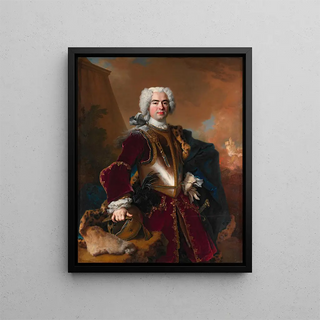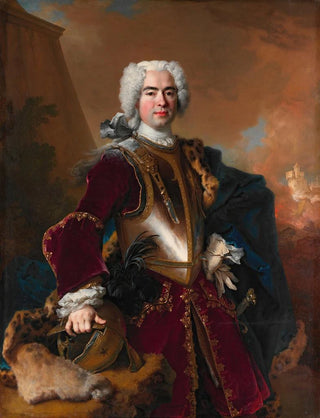Art print | André François Alloys de Theys d'Herculais 1692-1779 - Nicolas de Largillière


View from behind

Frame (optional)
André François Alloys de Theys d'Herculais 1692-1779 - Nicolas de Largillière – Engaging introduction
The artwork "André François Alloys de Theys d'Herculais 1692-1779" by Nicolas de Largillière is a masterpiece that evokes the elegance and sophistication of the 18th century. This portrait, capturing the essence of a man of his time, invites you to immerse yourself in the vibrant world of French painting. Largillière, as a renowned portraitist, succeeds in immortalizing not only the physical features of his subject but also his character and social status. The art print of this piece allows rediscovering a moment in history where art and society come together in harmonious dance, offering a window into a bygone era.
Style and uniqueness of the work
Largillière's style is distinguished by his keen eye for detail and mastery of colors. In this piece, each brushstroke appears meticulously calculated, creating a rich texture that brings the subject to life. The choice of colors, ranging from warm tones to darker shades, contributes to the atmosphere of nobility and dignity emanating from the portrait. The drapery of the clothing is rendered with such precision that it seems almost tangible, while the gaze of the character, both penetrating and serene, captures the viewer's attention. This ability to blend realism with a touch of romanticism is what makes the work so unique and timeless, allowing future generations to appreciate Largillière's genius.
The artist and his influence
Nicolas de Largillière, born in 1656, is one of the most influential artists of his time. Trained at the Flemish school, he managed to incorporate elements of baroque painting while developing a style that is uniquely his own. His approach to portraiture goes beyond mere physical representation; he seeks to capture the soul of his subjects. Through his works, he not only shaped the taste of his era but also paved the way for future portraitists. His influence is evident in the work of many artists who followed him, demonstrating the depth of his impact on the history of

Matte finish

View from behind

Frame (optional)
André François Alloys de Theys d'Herculais 1692-1779 - Nicolas de Largillière – Engaging introduction
The artwork "André François Alloys de Theys d'Herculais 1692-1779" by Nicolas de Largillière is a masterpiece that evokes the elegance and sophistication of the 18th century. This portrait, capturing the essence of a man of his time, invites you to immerse yourself in the vibrant world of French painting. Largillière, as a renowned portraitist, succeeds in immortalizing not only the physical features of his subject but also his character and social status. The art print of this piece allows rediscovering a moment in history where art and society come together in harmonious dance, offering a window into a bygone era.
Style and uniqueness of the work
Largillière's style is distinguished by his keen eye for detail and mastery of colors. In this piece, each brushstroke appears meticulously calculated, creating a rich texture that brings the subject to life. The choice of colors, ranging from warm tones to darker shades, contributes to the atmosphere of nobility and dignity emanating from the portrait. The drapery of the clothing is rendered with such precision that it seems almost tangible, while the gaze of the character, both penetrating and serene, captures the viewer's attention. This ability to blend realism with a touch of romanticism is what makes the work so unique and timeless, allowing future generations to appreciate Largillière's genius.
The artist and his influence
Nicolas de Largillière, born in 1656, is one of the most influential artists of his time. Trained at the Flemish school, he managed to incorporate elements of baroque painting while developing a style that is uniquely his own. His approach to portraiture goes beyond mere physical representation; he seeks to capture the soul of his subjects. Through his works, he not only shaped the taste of his era but also paved the way for future portraitists. His influence is evident in the work of many artists who followed him, demonstrating the depth of his impact on the history of






